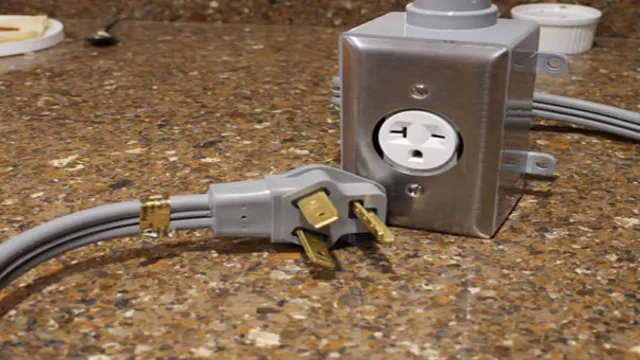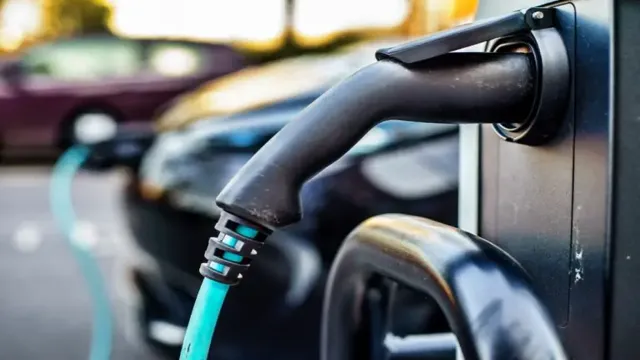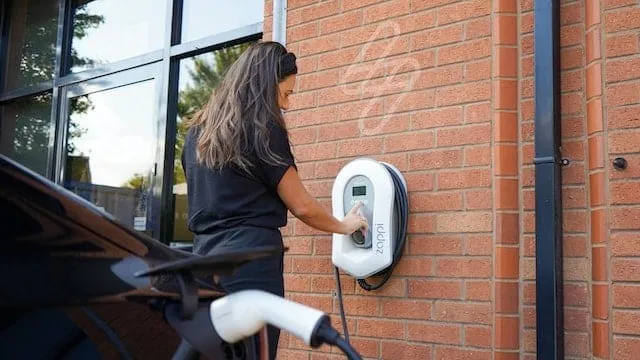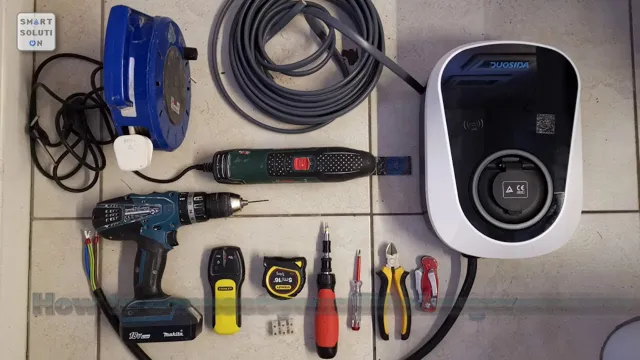Charge Up Your EV Anywhere: The Ultimate Guide to Plugging Your Electric Vehicle into a Regular Outlet
Are you considering making the switch to electric vehicles but concerned about charging options? One common question that arises is whether you can plug an EV into a regular outlet. The short answer is yes, you can, but there are some important considerations to keep in mind. Just like any other device that requires charging, electric cars can be charged using standard household outlets.
However, there are some limitations to using a regular outlet. For starters, it will take a much longer time to charge your electric car this way. Depending on the battery size of the EV, it can take anywhere from 8 to 24 hours to fully charge from a regular outlet.
This means you will have to plan your charging well in advance and make sure you have enough time to charge your car before you need to use it again. Another important consideration is the amount of energy that the outlet can provide. Most households have 120-volt outlets, which offer a lower amount of power output than a dedicated charging station.
This means that the charging process will be slower, and you may not be able to fully charge your car using a regular outlet alone. In addition, you may need to upgrade your home’s electrical wiring to support the increased load from charging an electric car. Overall, while it is possible to plug an EV into a regular outlet, it may not be the most efficient or practical way to charge your car.
Investing in a dedicated charging station is a better option if you want faster and more reliable charging. However, if you’re on a budget or have no other options, charging your EV using a regular outlet can be a viable solution. As with any decision related to electric cars, it’s important to weigh the pros and cons and do your research before making a decision.
Capacity of a Standard Outlet
If you’re wondering whether you can plug your electric vehicle into a standard outlet, the answer is yes, you can! Most electrical outlets in homes are capable of delivering up to 120 volts of power. However, it’s worth noting that while you can technically plug your EV into a regular outlet, it may not be the most practical or efficient option. This is because charging times will be slower, and you may need to leave your car plugged in for several hours to get a full charge.
Additionally, regular outlets may not be able to handle the high power demands of EVs, which could potentially lead to electrical issues such as tripped circuit breakers. For these reasons, it’s a good idea to consider installing a dedicated EV charging station for your home if you own an electric car. These stations are designed to deliver higher charging speeds and can be customized to suit your needs.
So while a standard outlet might work for occasional use, investing in an EV charging station is ultimately the best option for getting the most out of your electric vehicle.
Amps and Volts at Home
As homeowners, it’s important to understand the limits of your home’s electrical system to prevent overloading and potential fires. One critical area of knowledge is the capacity of a standard outlet, which can typically handle up to 15 amps at 120 volts. This means that devices with a high wattage, such as space heaters or hair dryers, should not be used in conjunction with other high-wattage devices.
It’s also important to note that older homes may not have the necessary wiring to support modern electrical demands. Always consult a licensed electrician if you’re unsure about the electrical capacity of your home. By staying informed and taking necessary precautions, you can keep your home and family safe from electrical hazards.

Calculating Your Car’s Charging Requirements
When it comes to charging your electric car, it’s essential to know the capacity of a standard outlet. A standard outlet in the United States typically has a voltage of 120V and a current of 15 amps, which gives it a power output of 8 kilowatts (kW).
However, it’s important to note that not all outlets are created equal, and the age and condition of the wiring can impact the charging speed of your electric car. If you’re considering using a standard outlet, it’s essential to check with an electrician to ensure that your home wiring is up to code and can handle the needs of your car. While charging your electric car from a standard outlet can be convenient, it’s important to remember that it will take longer to charge compared to other options such as a Level 2 charging station.
Potential Risks
Can you plug an EV into a regular outlet? The answer is yes, but it comes with potential risks. The first and most obvious risk is the outlet’s electrical capacity. Regular outlets typically provide 120 volts, which is not enough to charge most EVs in a reasonable amount of time.
It could take up to 20 or more hours to charge your vehicle fully. Additionally, continuous use of a regular outlet can cause it to overheat and potentially start a fire. Another issue is that certain EVs require a specific kind of outlet, and using a regular outlet could potentially damage the vehicle.
Lastly, plugging in your EV into a regular outlet could also overload your home’s electrical system, resulting in power outages or even more severe electrical problems. It is best to consult with a licensed electrician to ensure your home’s electrical capacity and outlets can handle your EV’s charging needs.
Fire Hazards
Fire hazards can pose significant dangers in our daily lives, and it is crucial to identify potential risks to prevent them from occurring. Electrical outlets, appliances, and heating systems can all contribute to fires if they are not maintained correctly or used appropriately. Smoking indoors, leaving candles unattended, and improper storage of flammable materials can also lead to disastrous consequences.
It is crucial to be aware of these hazards and take necessary precautions to reduce the risk of a fire. Keeping a fire extinguisher on hand, installing smoke detectors, and having an evacuation plan in place are all critical measures to take in case of an emergency. By being proactive and mindful of potential fire hazards, we can help keep our homes and communities safe.
Overloading the Circuit
Overloading a circuit can be tempting, especially when you have multiple devices to plug in and only a limited number of outlets. However, it’s important to understand that doing so can be potentially risky. Overloading a circuit can cause overheating and ultimately lead to an electrical fire.
It can also damage the devices plugged in, rendering them useless and costing you money in repairs or replacements. Additionally, overloading a circuit can result in tripped breakers or blown fuses, which can leave you without power until the issue is resolved. Remember, it’s always better to play it safe and use extension cords or surge protectors to spread out the load on different circuits, or consult an electrician to install additional outlets if necessary.
Stay safe and protect your devices by avoiding the temptation to overload your circuit.
Damaging the EV’s Batteries
When it comes to damaging an EV’s batteries, there are a few potential risks to consider. One of the biggest risks is overcharging the battery, which can cause it to overheat and potentially catch fire. Another risk is exposing the battery to extreme temperatures, as this can also cause damage or reduce the battery’s performance over time.
It’s important to note that while these risks do exist, modern EVs are designed to mitigate them through sophisticated battery management systems. That said, it’s still important to understand how to properly charge and care for your EV’s batteries to ensure they remain in good condition for years to come. When in doubt, it’s always best to consult the owner’s manual or speak with a qualified technician for guidance on EV battery care.
Solutions for Charging on a Standard Outlet
Yes, you can plug an EV into a regular outlet. However, charging an EV through a standard outlet may result in slow charging times and may not be the most efficient charging solution for a regular EV driver. To overcome this challenge, there are various solutions that can be used to increase the charging rate of an EV, such as buying an adapter that works with a higher voltage outlet, upgrading to a Level 2 charger, or using a portable charger.
These solutions will easily solve the problem of slow charging times and will provide a more reliable and efficient charging process for EV drivers. However, it’s important to ensure that the chosen solution is compatible with the specific EV model as well as the outlet specifications in your residential area. By investing in a proper charging solution, you can enjoy the maximum benefits of your EV and take advantage of the efficiency and cost benefits that come with it.
Using an Adapter
If you’re constantly on-the-go, keeping your devices charged can become a bit of a hassle. However, one solution for charging on a standard outlet is to use an adapter. These adapters can be a lifesaver, especially when traveling internationally or when there are limited charging options available.
They allow you to charge your device using a standard wall outlet, instead of having to rely on a specialized charging station or USB port. Some adapters even come equipped with multiple ports, allowing you to charge several devices at once. Investing in a quality adapter can make all the difference when it comes to keeping your devices fully charged and ready to go.
So next time you’re out and about, don’t forget to pack your adapter!
Installing a Dedicated Circuit
If you own an electric car, you will need a dedicated circuit for charging. But if this is not an option, there are still solutions for charging on a standard outlet. It is important to note that charging on a standard outlet, also known as Level 1 charging, is much slower than Level 2 charging on a dedicated circuit.
However, it can be a good option for occasional or emergency charging. Just plug your car into a standard outlet using the provided charging cord and wait for it to charge. Keep in mind that you may need to adjust your charging habits and allow for longer charging times.
Additionally, it is important to ensure that your outlet is in good condition and meets safety standards to avoid any potential hazards. So, while a dedicated circuit is ideal, charging on a standard outlet is still a feasible solution for electric car owners.
Final Thoughts
When it comes to plugging an electric vehicle into a regular outlet, the answer is a bit complicated. While technically speaking, most EVs can be charged using a standard 120-volt electrical outlet, it’s not recommended for everyday use. This is because it can take anywhere from 12-24 hours to charge an EV using a regular outlet, which is not practical for daily driving needs.
Additionally, using a regular outlet can put a strain on the electrical system in your home and potentially cause a fire. To ensure safe and efficient charging, it’s best to use a Level 2 charging station with a dedicated circuit and a higher voltage. This will allow for faster charging times and prevent any potential electrical hazards.
So while it’s possible to plug an EV into a regular outlet, it’s not the best option for long-term use.
Conclusion
In conclusion, while it is technically possible to plug an EV into a regular outlet, it’s about as wise as trying to fit a square peg into a round hole. Sure, you might get it to work for a little while, but it’s not sustainable and can even be dangerous. Think of it this way, your EV is a thoroughbred racehorse, and a regular outlet is a toddler’s tricycle.
Sure, they’re both modes of transportation, but one is clearly better suited for the job. So let’s leave the tricycles to the toddlers and invest in proper charging infrastructure for our EVs, so they can perform at their best and take us on the ride of our lives (literally).”
FAQs
What type of outlet is required to charge an EV?
EVs can be charged using a 120-volt regular household outlet, but it’s recommended to use a 240-volt outlet for faster charging.
Can charging an EV from a regular outlet cause damage?
It is possible to charge an EV from a regular outlet, but it may take a significantly longer time. However, there is no risk of damage to the car or the electrical system.
How long does it take to charge an EV from a regular outlet?
The time it takes to charge an EV from a regular outlet varies depending on the car and battery size. Generally, it takes around 12-24 hours for a full charge.
Is it safe to leave an EV charging overnight on a regular outlet?
It is safe to leave an EV charging overnight on a regular outlet, but it’s better to use a dedicated circuit for electrical safety and faster charging. It’s also recommended to use a smart charging system that can automatically stop charging when the car is fully charged.






